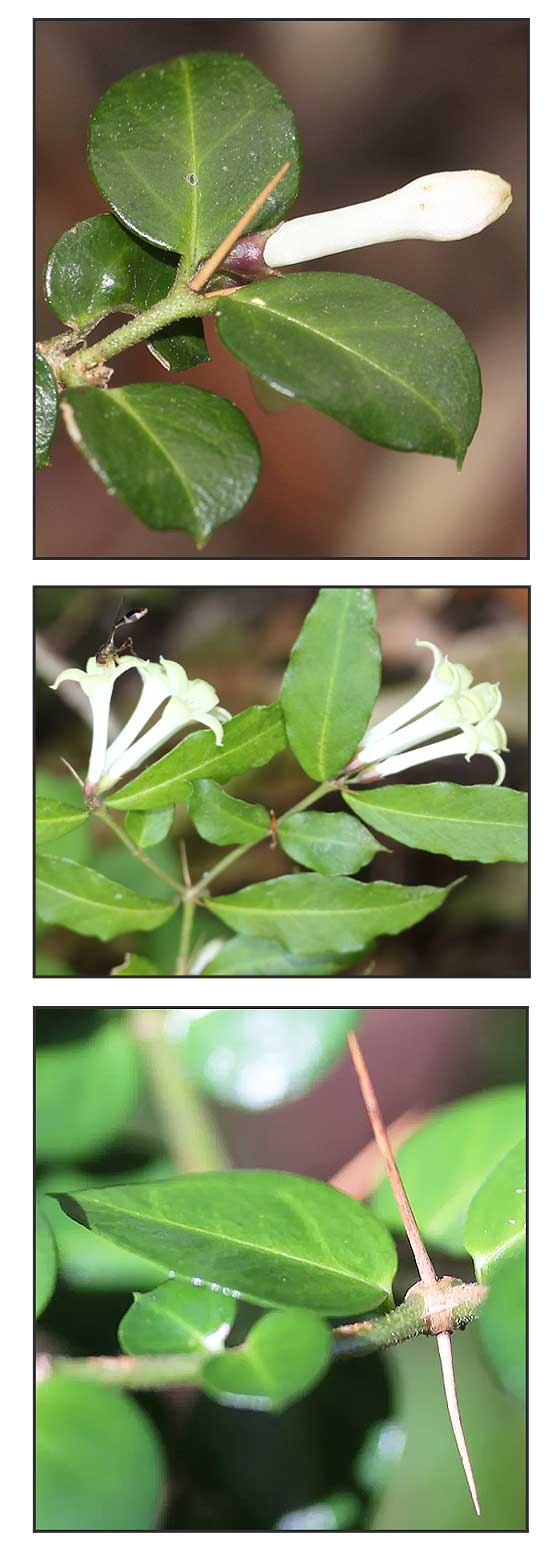
Family • Rubiaceae
Indian teak
Damnacanthus indicus C.F.Gaertn.
INDIAN DAMNACANTHUS
Hu ci
| Scientific names | Common names |
| Canthium gaertneri Steud. | Indian teak (Engl.) |
| Canthium indicum (C.F.Gaertn.) D.Dietr. | Indian damnacanthus (Engl.) |
| Damnacanthus indicus C.F.Gaertn. | |
| Accepted infraspecifics (3) | |
| Damnacanthus indicus var. indicus | |
| Carissa spinatum G.Lodd. | |
| Bridelia spinosa DC. | |
| Baumannia geminiflora DC. | |
| Damnacanthus formosanus (Nakai) Koidz. | |
| Damnacanthus indicus var. formosanus Nakai | |
| Damnacanthus indicus var. lancifolius Makino | |
| Damnacanthus indicus var. ovatus Koidz. | |
| Damnacanthus lancifolius (Makino) Koidz. | |
| Damnacanthus major var.lancifolius (Makino) Ohwi | |
| Damnacanthus major var. parvifolius Koidz. | |
| D. indicus var. microphyllus (Makino) Makino ex Nakai | |
| Damnacanthus indicus f. microphyllus Makino | |
| Damnacanthus indicus var. pseudogiganteus Hatus. | |
| Damnacanthus indicus C.F.Gaertn. is an accepted species. KEW: Plants of the World Online | |
| Other vernacular names |
| CHINA: Hu ci, Xiu hua zhen, Huang jiao ji. |
| JAPANESE: Ari-doshi, Ichi-ryo. |
Constituents Properties Availability |
November 2025
![]()
 |
| PHOTOS / ILLUSTRATIONS |
| IMAGE SOURCE: Damnacanthus indicus - Fruit and leaves / © Alpsdake / CC BY-SA 4.0 / Image modified / Click on image or link to go to source page / PictureThis |
| OTHER IMAGE SOURCE: Damnacanthus indicus - Leaves and thorn / © Alpsdake / CC BY-SA 4.0 / Image modified / Click on image or link to go to source page / PictureThis |
| OTHER IMAGE SOURCE: Damnacanthus indicus - Leaves and flowers / © Alpsdake / CC BY-SA 3.0 / Image modified / Click on image or link to go to source page / PictureThis |
| OTHER IMAGE SOURCE: Damnacanthus indicus - Leaves and flower bud / © Alpsdake / CC BY-SA 4.0 / Image modified / Click on image or link to go to source page / Wikipedia |
| OTHER IMAGE SOURCE: Damnacanthus indicus in Mount Tengura, Owase, Mie prefecture, Japan / Alpsdake / CC BY-SA 4.0 / Image modified / Click on image or link to go to source page / Wikipedia |
Additional
Sources and Suggested Readings |
• |
DOI: It is not uncommon for links on studies/sources to change. Copying and pasting the information on the search window or using the DOI (if available) will often redirect to the new link page. (Citing and Using a (DOI) Digital Object Identifier) |
| List of Understudied Philippine Medicinal Plants |
| New plant names needed The compilation now numbers over 1,730 medicinal plants. While I believe there are hundreds more that can be added to the collection, they are becoming more difficult to find. If you have a plant to suggest for inclusion, native or introduced, please email the info: scientific name (most helpful), local plant name (if known), any known folkloric medicinal use, and, if possible, a photo. Your help will be greatly appreciated. |
• |
 |

 Gen info
Gen info Distribution
Distribution